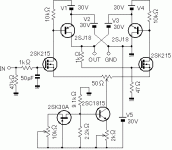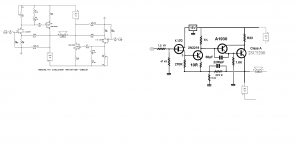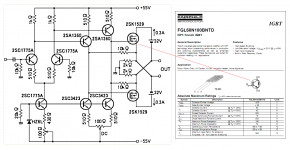Hallo together
the original circuit is mirror symmetric between pos and neg halves (so called "true complementary push pull") but in real life I missed the symmetric behavior - see foto about clipping
"Photograph 6: Stability at Clipping - 1kHz into 8ohms " by URL
http://diyaudioprojects.com/Solid/Jean-Hiraga-Le-Monstre/ (scoll down, last photo)
If you compare the rising edge of lower half to the falling edge of upper half, you see the different.
Additional the 300 KHz Sine Waves are more like a sawtooth, what is bad omen (no low IM distortion at high frequencies)
How I can I convert Hiraga's "Le Monstre" to a CSPP version (cross shunted push pull)? By the output stages allone I haven't problem (there are some examples on this forum), but include the input stage I don't find solutions.
Thank you very much for your advices
the original circuit is mirror symmetric between pos and neg halves (so called "true complementary push pull") but in real life I missed the symmetric behavior - see foto about clipping
"Photograph 6: Stability at Clipping - 1kHz into 8ohms " by URL
http://diyaudioprojects.com/Solid/Jean-Hiraga-Le-Monstre/ (scoll down, last photo)
If you compare the rising edge of lower half to the falling edge of upper half, you see the different.
Additional the 300 KHz Sine Waves are more like a sawtooth, what is bad omen (no low IM distortion at high frequencies)
How I can I convert Hiraga's "Le Monstre" to a CSPP version (cross shunted push pull)? By the output stages allone I haven't problem (there are some examples on this forum), but include the input stage I don't find solutions.
Thank you very much for your advices
Thank you for this schematic, that you have download fromGentle clipping:
2SJ18 CSPP Power Amplifier
There are more interesting topologies on this website:
Evolve Power Amplifiers
But nothing to find about SRPP input stages for voltage amplifier gain stages
tiefbassuebertr,
where and why on earth would you use SRPP input stages for voltage amplifier gain stages?
where and why on earth would you use SRPP input stages for voltage amplifier gain stages?
Lumba Ogir, for a maximal symetric behavior and CMR without LTP. But I think, the version of Nelson Pass match this requirement.
no problem - cut and paste is my first quality
need just half amp - a rail for two times
need just half amp - a rail for two times
Attachments
Last edited:
the topology by post #49 about
http://www.diyaudio.com/forums/pass-labs/3802-experimental-design-comments-flames-welcome-5.html
could be the appropriate solution
http://www.diyaudio.com/forums/pass-labs/3802-experimental-design-comments-flames-welcome-5.html
could be the appropriate solution
Elektor has got a couple of projects using JFET, I think, in SRPP.But nothing to find about SRPP input stages for voltage amplifier gain stages
One is an headphone amplifier. The other maybe preamp.
I will try to search our forum.
Following topics:
Veena - An Experimental SRPP Amplifier
shaan
SRPP (something like in the world of vacuum tubes) in solid state audio aplications
Bojan Hajdinjak
SRPP with FETS, what output stage?
davidallancole
jfet srpp preamp
yves
Last edited:
Very easy and very wishful thinking!
What sets the bias current of the output transistors and what keeps it thermally stable? And NO it's not simple substituting a Toshiba made-for-audio P-trench MOSFET with an IGBT 'just so'.
What sets the bias current of the output transistors and what keeps it thermally stable? And NO it's not simple substituting a Toshiba made-for-audio P-trench MOSFET with an IGBT 'just so'.
high values of source- (emitter-) resistors and large amount devices in parallel could be the right solution.Very easy and very wishful thinking!
What sets the bias current of the output transistors and what keeps it thermally stable? And NO it's not simple substituting a Toshiba made-for-audio P-trench MOSFET with an IGBT 'just so'.
Because there is no possibility in variation of the internal source resistor of the IGBT (and thus no predictable current distribution between the MOSFET part and the BjT part), I would avoid this kind of power device.
Hello diyers,
I have all parts for Stee's schematic amplifier at post 11 with 2SK1530 toshiba mosfets. Do I need to match the output mosfet? Did Stee already make this amp?
Thank you,
BR
Josh
I have all parts for Stee's schematic amplifier at post 11 with 2SK1530 toshiba mosfets. Do I need to match the output mosfet? Did Stee already make this amp?
Thank you,
BR
Josh
this approach looks goodreally no idea?
https://www.diyaudio.com/community/threads/i-call-it-infinitron.270239/
@ tiefbassuebertr
a question that has been bothering me for a few years, can you tell me how to pronounce your nickname in phonetic ? 😅
a question that has been bothering me for a few years, can you tell me how to pronounce your nickname in phonetic ? 😅
no; it was based on my previous company name and since a long time no longer exist website - go to@ tiefbassuebertr
a question that has been bothering me for a few years, can you tell me how to pronounce your nickname in phonetic ? 😅
https://web.archive.org/web/20061011153829/http://www.tiefbassuebertragung.de/9447.html
Since the number of characters for the nickname (in english "ultra low bass transmission") was not sufficient, it was garbled resp. corrupted by the moderation resp. their firmware.
Since confusion with such a nickname is impossible and I can now find old posts of mine more easily, I have not changed it until now.
Thank you for the answer 👍
I really like in-wall subs 🙂
I dismantled a (very ugly) fireplace at my house 15 days ago and I think the place would be perfect to put one in.
I have a pioneer tsw 303f 12" sub left which would make a good candidate and a huge yamaha sub which could well be one too and also two 38cm Davis carbon.
I really like in-wall subs 🙂
I dismantled a (very ugly) fireplace at my house 15 days ago and I think the place would be perfect to put one in.
I have a pioneer tsw 303f 12" sub left which would make a good candidate and a huge yamaha sub which could well be one too and also two 38cm Davis carbon.
- Home
- Amplifiers
- Solid State
- Conversion of Hiraga's "Le Monstre" to a Circlotron


